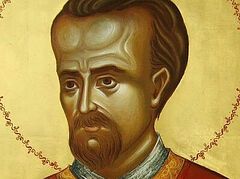Snegotin, Serbia, May 29, 2023
As happens every summer, thousands of Orthodox faithful attended the feast of St. Zosima the Wonderworker at Tuman Monastery in central Serbia yesterday, Sunday, May 28.
And this year’s festivities were blessed with the formal revesting of the relics of the great 14th-century saint.
“Guided by selfless love and gratitude, a river of people literally from all over the world flowed like a living river all afternoon and night to the monastery, begging for blessings and healings,” the monastery reports.
Authorities estimate that about 20,000 people visited the monastery throughout the day.
The Hierarchical Divine Liturgy was celebrated by His Grace Bishop Ignjatije of Braničevo, His Grace Bishop Heruvim of Osijek and Polje, His Grace Bishop Justin of Western Europe, and His Grace Bishop Petar of Toplica together with local and visiting clergy.
Following the Liturgy, the relics of the beloved St. Zosima were removed from his reliquary, and in the presence of the clergy and the faithful, were reverently revested. Pieces of the old vestments were distributed to those present as a blessing.
According to a decades-old tradition, the holy relics were carried in procession to St. Zosima’s hermitage cave, where they were placed for the veneration of the faithful.
The brotherhood then treated all to a festive meal.
***
 Photo: manastirtumane.org Little is known about the life of St. Zosima, known as the Sinaite. He is believed to have been a disciple of St. Gregory of Sinai, and thus he likely followed his elder to Serbia in the 14th century.
Photo: manastirtumane.org Little is known about the life of St. Zosima, known as the Sinaite. He is believed to have been a disciple of St. Gregory of Sinai, and thus he likely followed his elder to Serbia in the 14th century.
To devote himself to hesychasm, he arranged a space for living and prayer in a secluded cave. His zealous love for God drew people to him, and his memory has survived among the faithful throughout the generations.
Tradition says that St. Zosima reposed when he was fatally wounded by accident by Miloš Obilić, the famous hero of the Battle of Kosovo, who was hunting in the area where the ascetic was laboring. Obilić wanted to rush him off for treatment, but sensing that his hour of death was at hand, St. Zosima said, “Tu mani,” meaning he wanted to be left there to die. Obilić then began to build a monastery on the site in memory of St. Zosima.
Other sources say the name of the monastery comes from the local prince’s call to Obilić to stop the building of the monastery (“Tu mani”) because of the approaching Turkish army.
Whatever the case, the recorded folk traditions about St. Zosima testify that he is vividly remembered among the people. His tomb and later his reliquary have been a place of pilgrimage for centuries.
St. Zosima was formally canonized in 1962.
Follow OrthoChristian on Twitter, Vkontakte, Telegram, WhatsApp, MeWe, and Gab!






